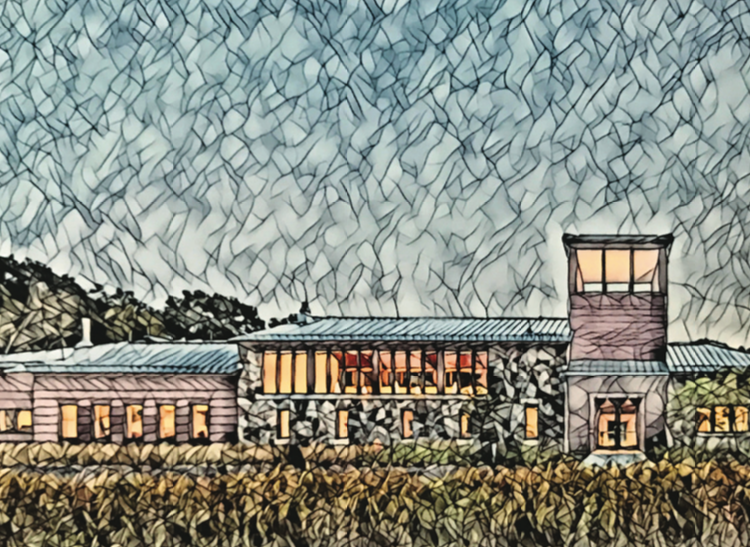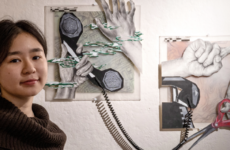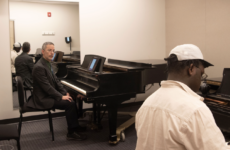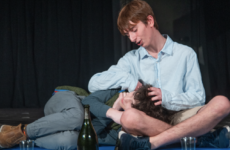Encountering art is inevitable. Everyone has seen some form of art in his or her lives, whether that is through symphonies, exhibitions, dances, writing, or musicals. However, Zev Nicolai-Scanio ’18 has developed a new form of art through an algorithm.
Nicolai-Scanio completed a Directed Study with his project advisor Dr. Matt Bardoe on machine and computer learning last term. The result of his project now decorates the stairwells of the Lanphier Center.
According to Nicolai-Scanio, his passion lies in computer science. He said, “I have always been interested in the algorithm side of computer science. It’s just been something that I have done in my free time, like taking CS50, which is Harvard University’s Introduction to Algorithm online. Last year, I took AP Computer Science, here at Choate, which had some basic algorithms, but we never had any electives that were specifically designed to teach the theory or concepts much further than what was the surface. So I decided to do a Directed Study in the fall, which was basically a college level course of computer science.” He added, “One of the things, in terms of family algorithms, that really interested me was artificial neural network or artificial intelligence. What it does is it stimulates the cognitive process of rows and rows of neurons propagating information. So I decided to continue my Directed Study in the winter, centering around artificial neural networks and their application in practical cases such as image recognition and handwriting transcriptions.”
Nicolai-Scanio’s work can be seen all throughout the Lanphier Center and exceeds the practical image recognition and handwriting transcriptions that are basic to computer science. Instead, his work takes a very artistic and complex form. He said, “I have always been interested in the way art morphs reality. If you look back in history, as the different art schools rise and fall, the ‘trend’ in art also changes. There is a long lineage of creative differences that moves from the still life to landscape paintings, so the idea of the human approaches to painting morphing over time, has always fascinated me.”
With this interest in mind, he began to work with algorithms and technology to replicate such art forms. Nicolai-Scanio said, “I wanted to use these new technologies that seem to have such a versatility with images. I wanted to see, theoretically, if people, separated by generations in time and by different art schools, could paint the exact same thing. In essence, I wanted to see two painters’ techniques being used on an identical composition.”
To many people, computer science may seem like a scary term. They may assume that designing such a project would have taken at least a year; however it took Nicolai-Scanio four weeks to write the proof for his project from scratch. He said, “Developing the first component of the project, which was the mathematical proof of why it should work, took me around four weeks before the end of the term. The project was two weeks of mathematical underpinning and two weeks of code. The rest was just training the models to do what you want it to do. Once that is achieved, the actual ‘painting’ only takes around five seconds.”
Nicolai-Scanio’s project breaks the barriers between art and science. He merged the two, blending the lines of mathematical theory and artistic expression. His work is the product of that fusion. Nicolai-Scanio said, “Even within art itself, there is a historical division between photography and painting. I tried to capture almost a timeline or a compression of artistic and computational history.” There are ten art pieces currently in the Lanphier Center.
As Nicolai-Scanio talked about his creative process, he explained it in terms of human learning. He explained, “The machine learns art the way humans do, just a little faster. The model makes guesses of the composition then reevaluates the errors and makes corrections. It imitates a certain painting style that I have put in the algorithm, then it compares it to the actual landscape and then again to the abstract technique of the imitated artist.” The machine repeats this process millions and millions of times, however with the input of mathematics and is able to create a matrix of the content and the perceived style.
Nicolai-Scanio has implemented many different artistic techniques and put them to the test of trial and error. He said, “I realized that a mosaic style work matches best with landscapes with light and open areas. It really accentuates the angles and reflections already present in the photo.” In one particular photo, Nicolai-Scanio experimented with the difference in geography. He elaborated, “I tried the artistic style of Japanese paintings that form in waves. I thought the difference in the mountain and wave forms would be an interesting comparison to see the landscape of land and water obfuscate.”
Each of the paintings is distinct with the technique and layers of thought used to generate the art. Nicolai-Scanio’s ‘art project’ took the codes within computers and generated art with a human fingerprint. Be on the lookout for his work along the stairwells of the math center.





